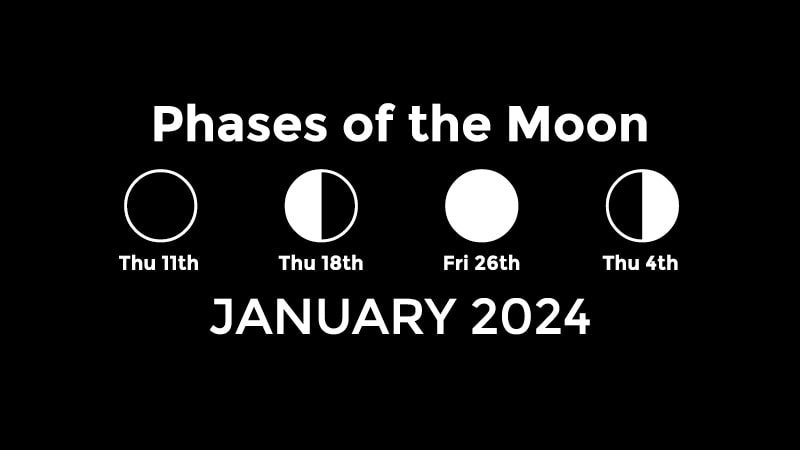Find out what to go out and look at this month
Planets:
In January’s early morning sky, Mercury embarks on its celestial journey, transitioning from the constellation of Ophiuchus (The Serpent-Bearer) to Sagittarius (The Archer). On the 12th of the month, it reaches its greatest elongation in the West, marking the moment before retracing its path towards the Sun. Venus commences the month positioned between the constellations of Libra (The Scales) and Scorpius (The Scorpion). Throughout January, its radiant presence graces the night sky as it gracefully traverses Scorpius, and Ophiuchus, and ultimately culminates in the constellation of Sagittarius. Mars, commencing its celestial voyage between Ophiuchus and Sagittarius, steadily progresses through the month, concluding its cosmic dance in the expansive realm of Sagittarius.
In the evening night sky, Jupiter‘s celestial residence in January is nestled between the mythological figures of Cetus (The Sea-Monster), and Aries (The Ram). Meanwhile, Saturn makes its ethereal abode in the constellation of Aquarius (The Water Bearer).
Uranus, the distant ice giant, graces the celestial tapestry between Taurus (The Bull), and Aries, adding a touch of cosmic allure to the vast expanse. Neptune, the enigmatic ice giant, holds its celestial presence between the mythical constellations of Cetus and Pisces (The Fish), contributing to the captivating dance of the planets in the night sky throughout the month.
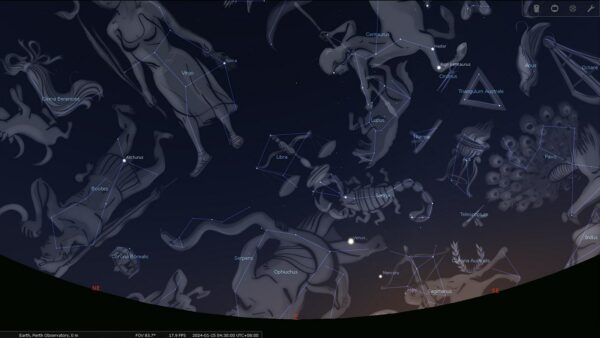
|
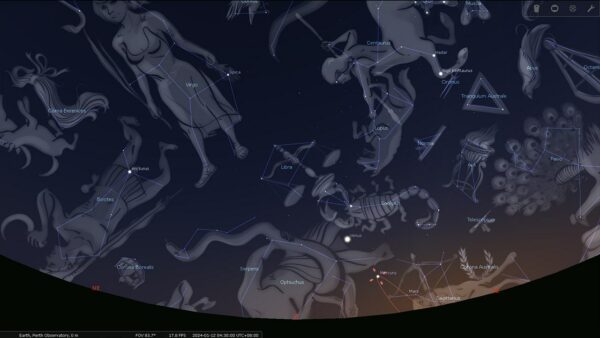
|
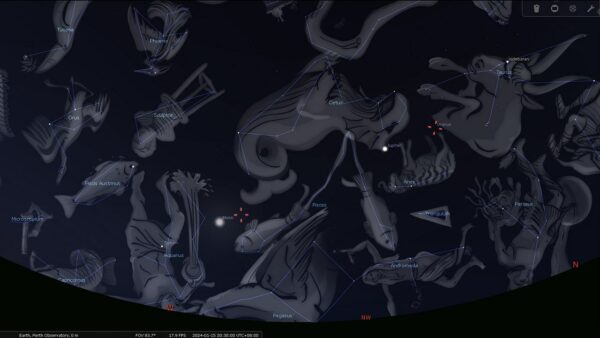
|
| Planet | When It Rises Or Sets |
|---|---|
| Mercury | At the start of January, it’ll rise at 04:06 am (AWST), and by the end of the month, it’ll rise at 04:09 am (AWST) |
| Venus | At the start of January, it’ll rise at 02:47 am (AWST), and by the end of the month, it’ll rise at 03:14 am (AWST) |
| Mars | At the start of January, it’ll rise at 04:16 am (AWST), and by the end of the month, it’ll rise at 03:59 am (AWST) |
| Jupiter | At the start of January, it’ll set at 01:22 am (AWST), and by the end of the month, it’ll set at 09:56 pm (AWST) |
| Saturn | At the start of January, it’ll set at 10:28 pm (AWST), and by the end of the month, it’ll set at 08:39 pm (AWST) |
| Uranus | At the start of January, it’ll set at 02:01 am (AWST), and by the end of the month, it’ll set at 11:48 pm (AWST) |
| Neptune | At the start of January, it’ll set at 11:26 pm (AWST), and by the end of the month, it’ll set at 09:23 pm (AWST) |
Conjunctions And Occultations:
Conjunctions involve object(s) in the Solar System and/or more distant objects, such as a star. It’s an apparent phenomenon in which multiple objects which aren’t close together appear close in the sky and it’s caused by the observer’s perspective.
In an occultation, an object passes across the line of sight between an observer and another object. A solar eclipse is an occultation of the Sun by the Moon.
- 05/01/24 – Conjunction of The Moon, and Spica (Where to look)
- 08/01/24 – Conjunction of The Moon, Venus, and Antares (Where to look)
- 09/01/24 – Conjunction of The Moon, Venus, and Antares (Where to look)
- 10/01/24 – Conjunction of The Moon, and Mars (Where to look)
- 14/01/24 – Conjunction of The Moon, and Saturn (Where to look)
- 18/01/24 – Conjunction of The Moon, and Jupiter (Where to look)
- 20/01/24 – Conjunction of The Moon, and Pleiades (Where to look)
- 22/01/24 – Conjunction of The Moon, and Elnath (Where to look)
- 24/01/24 – Conjunction of The Moon, Castor, and Pollux (Where to look)
- 28/01/24 – Conjunction of The Moon, and Regulus (Where to look)
- 28/01/24 – Conjunction of Mercury, and Mars (Where to look)
Astronomical Events This Month:
Earth At Perihelion:
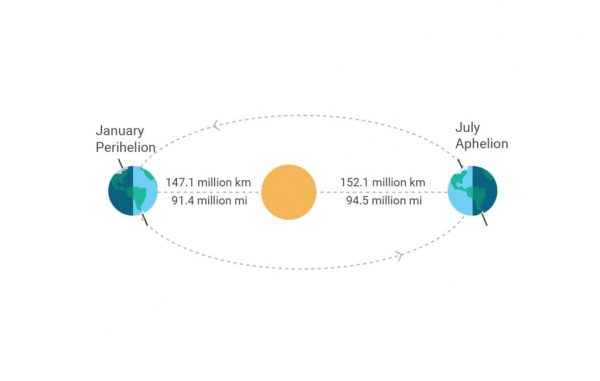
The Earth will be at its closest point to the Sun (at Perihelion), about two weeks after the December Solstice at 08:38 am (AWST) on Wednesday the 3rd of January. The Earth will be 147,100,632 km away from the Sun that day and this occurs because the Earth’s orbit is elliptical. Approximately every 100,000 years, Earth’s orbital path changes from being nearly circular to elliptical. This is due to the gravitational influences of other planetary objects, particularly the Moon. The difference in the Earth’s orbital path from a perfect circle is known as its eccentricity. Also, the word Perihelion comes from ancient Greek, where Peri means close, and Helios means the Sun.
The Quadrantids Meteor Shower:
The Quadrantids are the first major shower of the year, and for those living in North America, much of Europe, and the majority of Asia you’ll be able to view them. Unfortunately, for us living in Australia and lower portions of South America and Africa, we won’t be able to view this shower as its radiant point (where the shower appears to be coming from) is in the Northern Hemisphere’s sky.
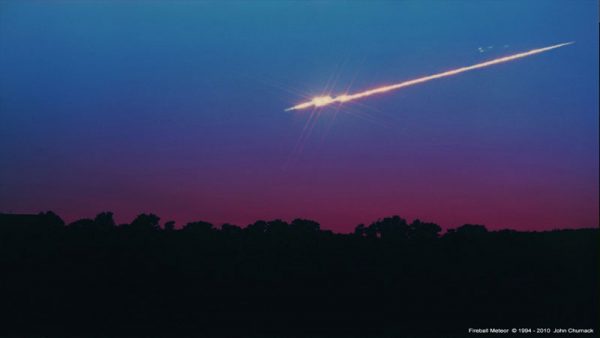
The Quadrantids are an annual shower that has one of the highest predicted hourly rates of all the major showers (40-120 meteors per hour to be more accurate) and it’s comparable to August’s Perseids for the Northern Hemisphere and December’s Geminids for the Southern Hemisphere. The object that causes the Quadrantids was tentatively identified back in 2003 by Peter Jenniskens as the minor planet 2003 EH1, which could be related to the comet C/1490 Y1 which was observed by Chinese, Japanese and Korean astronomers some 500 years ago.
The name comes from the former constellation Quadrans Muralis, which was created in 1795 by the French astronomer Jérôme Lalande and is now part of the Boötes Constellation. The meteor shower was first noticed in early January 1825, by Antonio Brucalassi in Italy who reported that “The atmosphere was traversed by a multitude of the luminous bodies known by the name of falling stars”, and that they appeared to radiate from the Quadrans Muralis Constellation. In 1839, Adolphe Quetelet of Brussels Observatory in Belgium and Edward C. Herrick who was in Connecticut independently suggested that the Quadrantids were an annual shower.
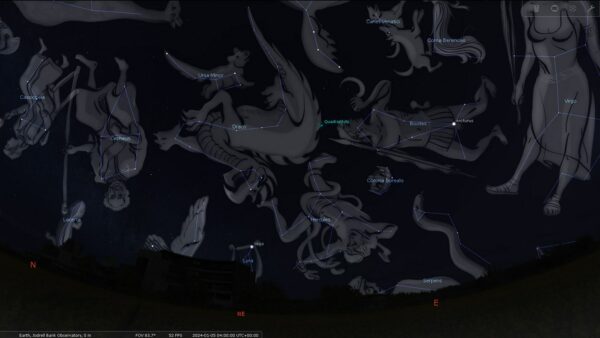
The meteor shower is active from the 28th of December through to the 12th of January with the peak being on the morning of Friday the 5th of January. If you live in the Northern Hemisphere and want to view the Quadrantids, you need to get up at around 2 am and look towards the Boötes Constellation which is the radiant point for the shower and not far from the Big Dipper. This year the Moon will be in its Full Moon phase, so people will have to deal with a lot of light pollution from it, which means you won’t see the fainter meteors.
Things to Look at This Month:
California Nebula:
The California Nebula (NGC 1499) is an emission nebula located in the constellation of Perseus. Its name is due to its resemblance to the outline of California in long-exposure photographs. Because of its very low surface brightness, it is extremely difficult to observe visually but it is a great Astrophotography target. It can be observed with a Hα filter or Hβ filter in a rich-field telescope under dark skies.
The nebule lies at about 1,000 light-years from Earth and is 60 light-years across. Its fluorescence is due to the excitation of the Hβ line in the nebula by the nearby star, Xi Persei (also known as Menkib). The California Nebula was discovered by Edward Emerson Barnard in 1884.
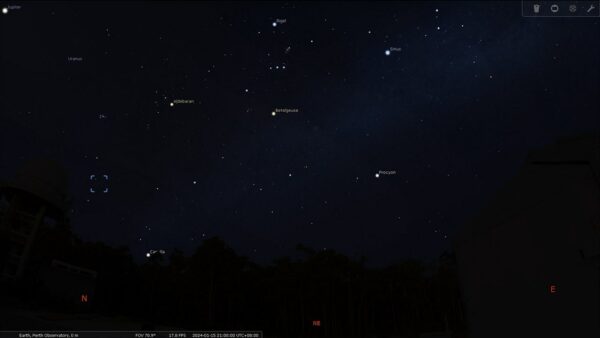
|
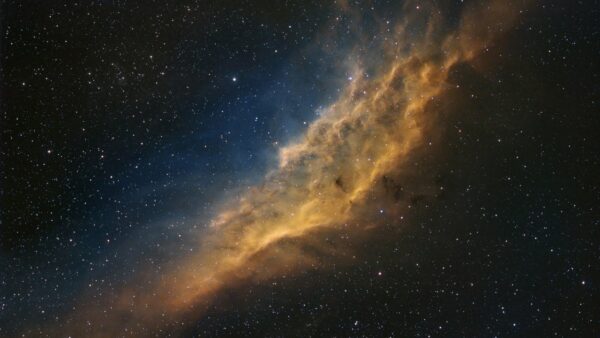
|
Horsehead Nebula:
The Horsehead Nebula is a small dark nebula in the constellation Orion (The Hunter). The nebula is located just to the south of Alnitak, the easternmost star of Orion’s Belt, and is part of the much larger Orion molecular cloud complex. It appears within the southern region of the dense dust cloud known as Lynds 1630, along the edge of the much larger, active star-forming H II region called IC 434.
The Horsehead Nebula is approximately 1,375 light-years from Earth, and It is one of the most identifiable nebulae because it resembles a horse’s head. The nebula was first recorded in 1888 by Scottish astronomer Williamina Fleming on a photographic plate taken at the Harvard College Observatory. Like the California nebula, it’s an astrophotography target as it appears very faint through a large telescope.
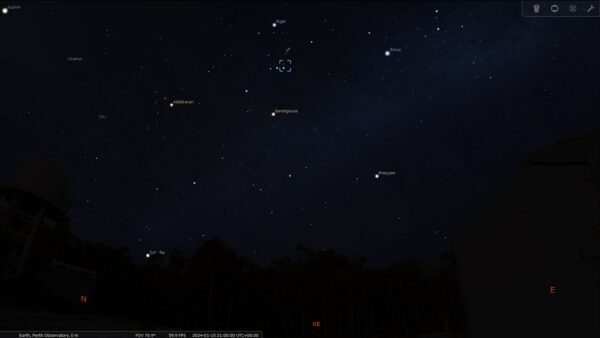
|
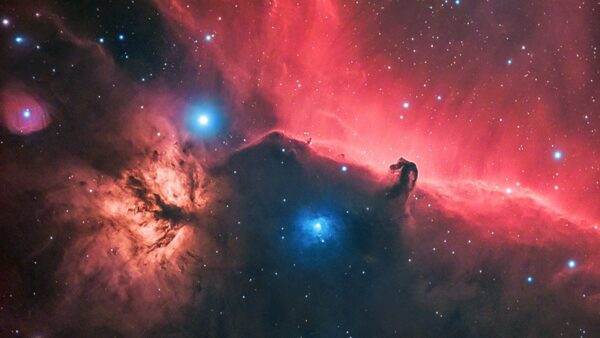
|
Winter Albireo:
Winter Albireo (H3945 and SAO173349) is a visual double star in the constellation Canis Major and is named by Sir John Herschel (son of Sir William) and sometimes referred to as “Herschel’s Lovely Double” or the “Southern Albireo”.
This is not a binary system, but two stars in the same line of sight. The primary star HIP35210 is a Supergiant, ‘citrus orange’ in colour is much further away at 6523 light-years away compared to its companion star HIP35213 which is a ‘royal blue’ coloured star at 258 light-years away. Both stars are close double stars themselves with narrow separation, not visible in our modest telescopes.
The orange star is a Supergiant over twice the diameter of Betelgeuse with a diameter of 2.6 billion km. It would encompass the orbit of Jupiter if in place of our Sun. It is also ~365,000 times brighter than the sun because of its size, however, it has a much cooler surface temperature of ~3 300 K.
The secondary star is a much smaller main-sequence star at ~2.9 times the diameter of the sun and ~22 times the brightness with a much higher surface temperature of ~7 300K.
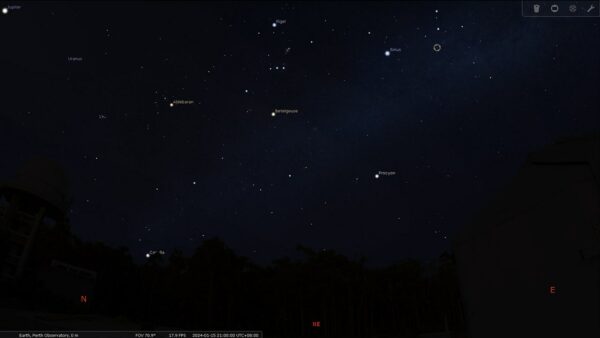
|
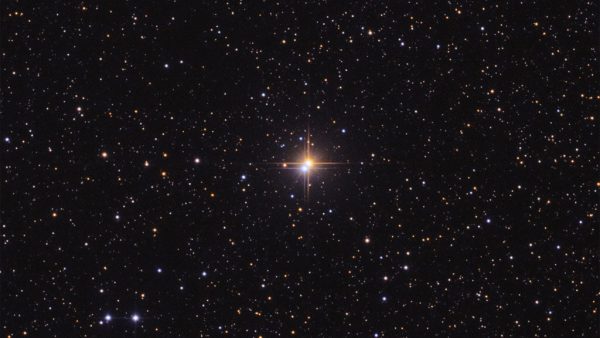
|
Wishing Well Cluster:
The Wishing Well Cluster (NGC 3532) is an open cluster in the constellation of Carina (The Keel). The cluster is located 1,600 light-years from Earth and is 24 light-years across. 677 stars are recognised as members of the cluster, and the cluster is rich in binary stars. It is estimated to be around 300 million years old and has ~ 2,000 solar masses.
To the naked eye, the cluster looks like an enhancement of the Milky Way, but by using a pair of binoculars or a telescope you’ll see five dozen or more stars. Its discovery is credited to 18th Century European explorer Louis de Lacaille who included it in his 1755 catalogue. The cluster is also known as the Firefly Party Cluster, and Black Arrow Cluster.
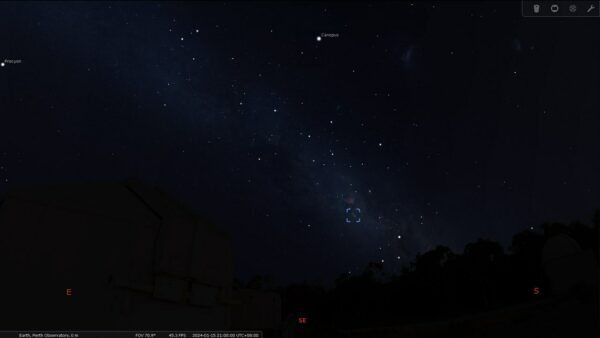
|
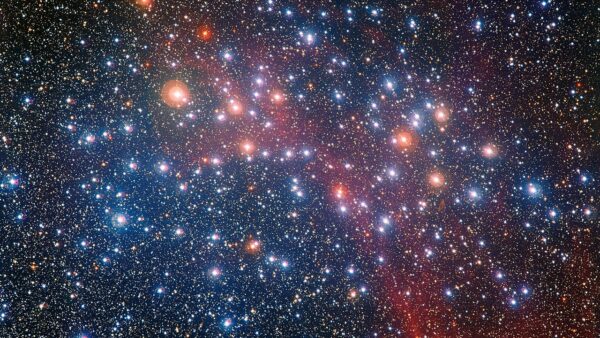
|
Phases Of The Moon:
